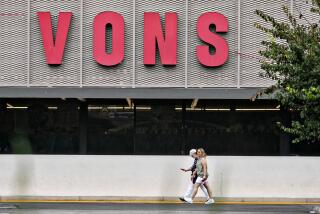Missing the Latin Beat : Vons Is Experiencing Problems With Its Mexican-Style Markets
- Share via
Sonia Zepede is the sort of shopper Vons Cos. had in mind when it opened its Tianguis markets six years ago. Her roots--and culinary tastes--trace to Mexico, and she looks for native foods when she shops.
But Zepede prefers her neighborhood Lucky store to a nearby Tianguis, despite its broader selection of Latin foods. “Tianguis is too expensive,” said Zepede, 26.
In a region where one of every three shoppers is Latino, the large, modern Tianguis markets are notable for their lack of success with such consumers as Zepede. Competitors, industry analysts and others familiar with Tianguis say there are important reasons why shoppers go elsewhere: weak marketing, increased competition for Latino food dollars and a perception that prices are high.
An overnight success when it opened, Tianguis has apparently become a victim of corporate distraction, among other things. As the popularity of low-price club stores threatened its mainstream supermarkets, Vons Cos. in recent years turned its attention to its namesake grocery stores and its new club-style Expo markets, while continuing to nurture its Pavilions chain, which is aimed at coveted upscale shoppers.
While acknowledging Tianguis has problems, Vons executives declined to discuss them. Vons is converting the store in Zepede’s El Monte neighborhood to an Expo market, and is considering similar changes for the eight Tianguis stores that remain. Though no decision has been made to scrap the chain, analysts expect that to happen.
With recession cutting into sales companywide, Vons, which invested heavily in new stores in the last eight years, is coming under pressure to streamline. Cash generated by store operations, the source of funds for remodeling and expansion, fell 8.9% in the quarter ended June 30. Earlier this week, Vons President Dennis Eck abruptly resigned, and more changes are expected.
*
“The bigger picture is surviving in Southern California,” said Douglas Christopher, an analyst with Crowell, Weeden in Los Angeles. He called Tianguis “a drag on the company.”
Combining the polish of a modern supermarket with the atmosphere of a swap meet, Tianguis is among the supermarket industry’s most ambitious attempts to attract Latino consumers. Many supermarket chains adjust their food selection to neighborhood tastes, expanding the selection of chiles and pork cuts in Latino communities, for example.
Vons took the concept a step further, forming a partnership with a Mexican company to import native foods and groceries and designing a store to accommodate Latino tastes.
The move was driven not only by demographics but also by the scattered nature of the ethnic grocery business, divided in Latino neighborhoods among dozens of small, family-run carnicerias, or butcher shops; bakeries, or panaderias , and small tortilla factories.
With Tianguis, Vons assembled these businesses under one roof, offering consumers one-stop shopping for a broad selection of foods and household goods and consistent service.
Tianguis at first made inroads with consumers drawn by fresh-baked tortillas, Mexican-style sausages and dried cactus leaves--neatly stacked along wide aisles. On weekends, mariachi bands played outside the stores and vendors sold fresh tamales.
Longtime Latino grocer Joseph Sanchez said competition from Tianguis forced him to close a family-owned market in Pico Rivera in 1989, although he continues to run stores at other locations. “They were really booming,” he said. “People came from miles away to shop at those stores.”
*
Eight stores opened in two years, but Tianguis’ rapid expansion ground to a near-halt in 1989. Only one store has opened since. In addition to El Monte, other locations include Cudahy, Huntington Park, Montebello, San Fernando, two in East Los Angeles and two in Echo Park.
Vons spokeswoman Mary A. McAboy attributed the lack of recent investment in Tianguis to its declining performance, exacerbated by the recession.
“Tianguis sales have been weak and continue to be weak,” she said.
Vons Vice President Edward A. Marrujo, who is responsible for Tianguis as well as the new Expo markets, declined to comment.
Tianguis’ difficulties aren’t purely economic. Along with Vons’ other stores, Tianguis was the target of a now-suspended boycott organized by the United Farm Workers union, whose members are largely Latino. For two years, ending in 1992, the UFW asked consumers not to shop at Vons, which, as the region’s largest supermarket company, is the largest seller of grapes in Southern California. The UFW contends that grapes are grown with pesticides harmful to fieldworkers.
The boycott appears to have had an impact on Tianguis. A telephone survey showed that Tianguis stores have quietly stopped selling grapes, as one produce manager put it, “because of the boycott.” However, Vons spokeswoman McAboy said decisions to not sell grapes are based on customer demand, not the boycott.
Steve Soto, president of the Mexican American Grocers Assn., said Tianguis appeared to suffer from corporate inattention at a time when competitors increased their focus on Latino business.
In the last two years, Food 4 Less Supermarkets Inc. has opened its Latin-oriented Viva Markets, while Lucky stores has increased its selection of Mexican foods. Spanish-language billboards for Lucky stores dot Latino neighborhoods in Los Angeles County.
Meanwhile, Vons appears to have curtailed promotional spending for Tianguis, reducing the specials and coupons offered to customers, Soto said. During one recent week, a Tianguis promotional flyer listed 70 specials and had one coupon, while a Pavilions flyer listed 225 specials and had eight coupons. The typical Tianguis store is slightly larger than the average Pavilions and about 50% larger than the average Vons.
Vons spokeswoman McAboy said promotional spending fluctuates from week to week but in general is a function of sales. She said she couldn’t say whether spending has declined in the last year or so.
*
According to customers and industry observers, the lack of specials doesn’t reflect lower overall prices. While prices on fresh produce are said to be low at Tianguis, customers complain that groceries are higher than at other stores. A random survey comparing grocery prices at the El Monte Tianguis to prices at a Vons 1 1/2 miles away turned up some big differences, although Tianguis wasn’t always the highest.
Tianguis customers paid 9.7% more for a 50-count bottle of Tylenol, 7% more for a six-pack of Squeeze It juice drinks and 1% more for a two-gallon twin pack of whole milk. The price of a 64-ounce bottle of Mott’s apple juice was 25% higher at Tianguis than at Vons, which had the item on sale.
However, Tianguis customers paid 2% less for a 36-count pack of Pampers. Prices charged for Cheerios, Wonder Bread, a six-pack of Pepsi and a dozen large eggs were the same at both stores.
People familiar with Tianguis believe the chain is worth preserving, but question whether Vons has the will to overcome its problems.
“To succeed in this market, it takes commitment,” Soto said. “In the last few years, the commitment hasn’t been there.”
Times staff writer George White contributed to this story.
More to Read
Inside the business of entertainment
The Wide Shot brings you news, analysis and insights on everything from streaming wars to production — and what it all means for the future.
You may occasionally receive promotional content from the Los Angeles Times.










